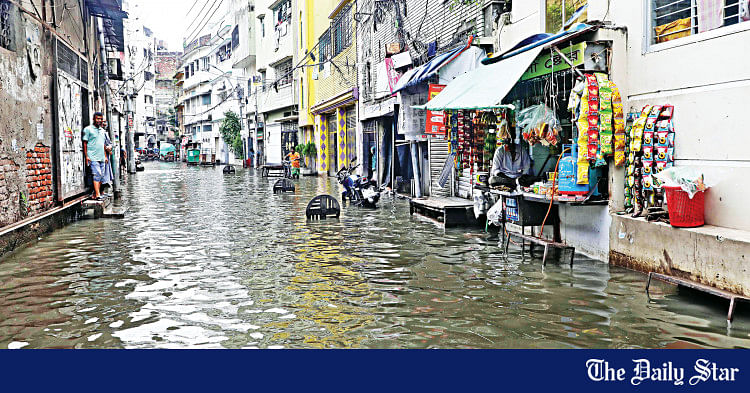– What are the health hazards associated with waterlogging in Dhaka City?
Is Dhaka City Doomed to Forever Battle Waterlogging Issues?
As the capital of Bangladesh, Dhaka City has long been plagued by waterlogging issues, with frequent bouts of flooding causing havoc for residents and businesses alike. The city’s low-lying geography, coupled with poor drainage systems and rapid urbanization, have contributed to the recurring problem of waterlogging.
The Root of the Issue:
Dhaka’s waterlogging issues stem from a combination of natural and man-made factors, including:
- Geographical Location: Dhaka is situated in a low-lying deltaic region, making it prone to flooding during heavy rainfall and monsoon season.
- Poor Drainage Infrastructure: The city’s drainage systems are often inadequate or poorly maintained, leading to water accumulation on roads and in residential areas.
- Urbanization: Rapid population growth and urban development have led to the encroachment of water bodies and wetlands, further exacerbating the city’s waterlogging problems.
Challenges Faced by Dhaka City:
The waterlogging issues in Dhaka City present a range of challenges, including:
- Traffic Congestion: Flooded roads and streets disrupt the flow of traffic, leading to long delays and significant economic losses.
- Health Hazards: Stagnant water serves as a breeding ground for mosquitoes and other disease-carrying insects, increasing the risk of waterborne illnesses.
- Property Damage: Floodwaters can damage homes, businesses, and infrastructure, resulting in costly repairs and displaced residents.
Efforts to Combat Waterlogging:
Over the years, various measures have been implemented to address Dhaka City’s waterlogging issues, including:
- Improving Drainage Systems: The government has invested in upgrading the city’s drainage infrastructure to enhance water flow and reduce flooding.
- Constructing Retention Ponds: Retention ponds and rain gardens have been built to capture and store excess rainwater, helping to alleviate drainage problems.
- Raising Road Levels: Some areas of the city have had their road levels raised to prevent water from pooling on the streets during heavy rainfall.
Future Prospects and Solutions:
While significant progress has been made in addressing Dhaka City’s waterlogging issues, more needs to be done to ensure sustainable solutions. Some potential strategies for the future include:
- Green Infrastructure: Implementing green roofs, permeable pavements, and tree plantings can help absorb rainwater and reduce runoff.
- Floodplain Management: Preserving and restoring natural floodplains can provide additional storage capacity for excess water during heavy rainfall.
- Community Engagement: Encouraging community participation in water management initiatives can help raise awareness and promote sustainable practices.
Conclusion:
Despite the challenges faced by Dhaka City in battling waterlogging issues, ongoing efforts and innovative solutions offer hope for a more resilient and sustainable future. By addressing the root causes of flooding and engaging stakeholders at all levels, the city can work towards minimizing the impact of waterlogging and creating a safer environment for all residents. With continued investment in infrastructure and coordinated planning, Dhaka City can overcome its waterlogging challenges and emerge stronger than ever before.
The Challenge of Waterlogging in Dhaka City
Despite significant efforts and an expenditure of Tk 730 crore in the past four years, Dhaka city corporations have made little progress in addressing the waterlogging issue. Recent heavy rains submerged at least 22 areas in the capital, causing inconvenience to residents and commuters, with some areas remaining flooded for over 36 hours.
City corporations took over the responsibility for canal and drainage management from Wasa in December 2020. However, the lack of effective planning and management has hindered any tangible improvements in resolving the waterlogging problem. According to Mujibur Rahman, a former Buet professor, the flawed drainage system, inadequate maintenance, and disruptions from road construction activities have contributed to the issue.
City corporation officials revealed that the allocated funds were utilized for cleaning canals, canal-drains, and box culverts, as well as waste removal. Despite these efforts, the canals quickly became clogged again after a few days. The recent heavy rainfall, recording 130mm in just six hours, exacerbated the waterlogging situation in various areas across Dhaka.
Experts emphasize the need for more strategic planning and management by the city corporations. Filling up of water bodies, canals, and lakes, coupled with a substandard drainage network, have exacerbated the persistent waterlogging problem. Climate change predictions indicate more intense rainfall in shorter durations, further threatening the situation.
To address the issue effectively, city corporations must enhance their capacities, improve skills, increase manpower, and implement institutional reforms. Developing a master plan to restore canals, water bodies, and establish a primary drainage system is imperative. Before the city corporations assumed responsibility, efforts to combat waterlogging primarily focused on open drains. Now, with added responsibility for canals and drains, substantial financial investments are required.
Despite significant investments by the DNCC and DSCC over the past four years, areas like Shantinagar continue to face severe waterlogging issues. Encroachment and narrowing of essential drainage canals over time have worsened the situation. The continual dumping of waste into drains by city dwellers and ongoing development projects by various agencies further contribute to the problem.
Calls for public involvement in initiatives to address waterlogging have been stressed by experts. The loss of water bodies in Dhaka over the past two decades, as highlighted by a 2019 BIP study, underscores the urgent need for qualitative changes in urban planning and management.
It is imperative for the city corporations to focus on nature-based drainage systems and take legal action against housing companies encroaching on lowlands. Comprehensively addressing the waterlogging issue will require a holistic approach, taking into account the importance of nature in sustainable urban development. Identifying the root causes of failure in existing projects is crucial for devising effective solutions moving forward.
